

Gallery Walk. Jordana Mazzarotto, Ana Francisca Rosada: Creating a positive learning environment. Date: 8 October 2016 Link to the recorded talk: This workshop relates to the “Managing the Lesson” professional practice, as specified on the British Council’s Continuing Professional Development (CPD) Framework for teachers.
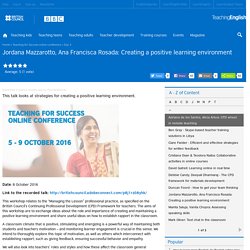
The aims of this workshop are to exchange ideas about the role and importance of creating and maintaining a positive learning environment and share useful ideas on how to establish rapport in the classroom. A classroom climate that is positive, stimulating and energizing is a powerful way of maintaining both students and teachers motivation – and monitoring learner engagement is crucial in this sense. We intend to thoroughly explore this topic of motivation, as well as others which interconnect with establishing rapport, such as giving feedback, ensuring successful behavior and empathy. We will also look into teachers’ roles and styles and how these affect the classroom general atmosphere - while still respecting and acknowledging our differences.
About the speakers: Crime and Punishment: Conversation Topic. Image credit: www.theguardian.com.
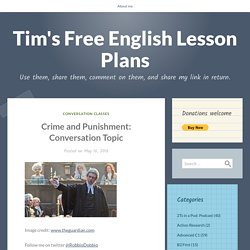
Activities for Learners. Sample Units. Arnold Palmer. Stories that Move. Taboos & issues advanced. Differentiated Instruction: Resource Roundup. Understanding Differentiated Instruction Summer DI Readings List: 150+ Seedlings for Growing Stronger Learners: Browse a bountiful reading list as you plan your garden of differentiated-instruction methods and strategies for the year. (Edutopia, 2015) Myth-Busting Differentiated Instruction: 3 Myths and 3 Truths: Get to the bottom of common misconceptions about differentiated instruction. For a quick reference on what differentiated is -- and what it isn't -- Differentiation Is / Differentiation Is Not, a set of infographics from ASCD, is also worth checking out.
(Edutopia, 2015) Defining Differentiated Instruction: Take a look at a few specific examples to better understand differentiated instruction in practice: using graphic organizers, offering alternative assignments, and providing extended work time. (Edutopia, Updated 2014) Differentiation Concept Map: Reference a flowchart that shows key elements of differentiated instruction and relationships among those elements. Equity vs. Engaging with SEN – inclusive assessment approaches - TeachingEnglish Training. This site uses cookies to help make it more useful to you.

By continuing to use the site you agree to our use of cookies. Use the ‘More info’ button to read more about our cookies. More info. Adapting materials for mixed ability classes. In these cases it’s important to remember that all students will get something out of the class, but not necessarily the same things, and not necessarily what you aim to teach them!

For example, the beginners may begin to get a grasp of your classroom language whilst the stronger students may begin to be able to put a new tense into use. Adapting materials for mixed ability classes can take different forms. One way to adapt materials is to rewrite reading texts and grade the language accordingly for different levels. In an ideal world where a teacher has all the time in the world to prepare their classes this may be the perfect solution. Educational Leadership:How to Differentiate Instruction:Reconcilable Differences? Standards-Based Teaching and Differentiation.
TeachingEnglish. Activity 3a Tiered Assignments. Total physical response - TPR. Where is it from?

How can I use it in class? When should I use it? Why should I use it in the classroom? A few useful variations Are there any disadvantages with using TPR? 50 Educational Podcasts You Should Check Out. Book Creator - the simple way to create beautiful ebooks. What is retrieval practice? — Retrieval Practice. When we think about learning, we typically focus on getting information into students’ heads.
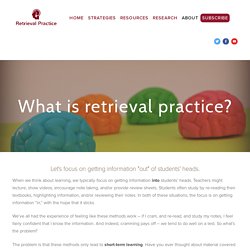
Teachers might lecture, show videos, encourage note taking, and/or provide review sheets. Students often study by re-reading their textbooks, highlighting information, and/or reviewing their notes. In both of these situations, the focus is on getting information “in,” with the hope that it sticks. We’ve all had the experience of feeling like these methods work – if I cram, and re-read, and study my notes, I feel fairly confident that I know the information.
And indeed, cramming pays off – we tend to do well on a test. The problem is that these methods only lead to short-term learning. Privilege Walk Lesson Plan. Privilege Walk Lesson Plan.

Fast finishers. Most teachers recognise the need to give early finishers something to do – something to keep them from being bored; something that will keep them from disrupting or distracting the rest of the class; something that will address their need to learn at a faster rhythm than the rest of the class.

But what? What makes an ideal activity for fast finishers? Apart from appropriate linguistic content, careful consideration has to be given to the following aspects of the activity: The teacher cannot give the fast finishers much of his/her time, as other students in the room may need his/her help and attention. Ideal activities for fast finishers need to be immediately self explanatory so that the students can be autonomous. Timing It may not be long before the rest of the class finishes the activity in hand, so any extra activity given to fast finishers must be something they can do quickly, or something that they can put down at a moment’s notice.
Correction & feedback. Lourdes Ortega at IATEFL 2018 on what SLA research is good for. The first plenary of the 2018 IATEFL conference in Brighton in April was given by Lourdes Ortega on the topic of What is SLA research good for, anyway?
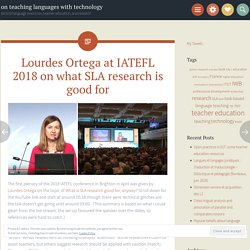
Scroll down for the YouTube link and start at around 05:18 though there were technical glitches are the talk doesn’t get going until around 09:00. (This summary is based on what I could glean from the live stream: the set-up favoured the speaker over the slides, so references were hard to catch.) Ortega started with a familiar opposition between teachers as practice-oriented “artists” versus researchers as thinking-oriented “scientists.” ClassroomScreen. WordBooster - For Creating Learning Around Authentic Text. When technology first came along we were all told that it would save us time and make our lives easier, and yet here we are many years later working harder than ever.
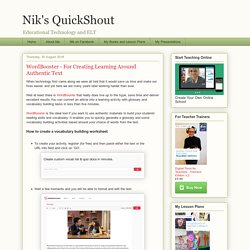
Well at least there is WordBooster that really does live up to the hype, save time and deliver excellent results.You can convert an article into a learning activity with glossary and vocabulary building tasks in less than five minutes. WordBooster is the ideal tool if you want to use authentic materials to build your students’ reading skills and vocabulary. It enables you to quickly generate a glossary and some vocabulary building activities based around your choice of words from the text. How to create a vocabulary building worksheet To create your activity, register (for free) and then paste either the text or the URL into field and click on ‘GO'.
Nik's QuickShout. Lessons from research. ELT Research Bites – More than just an abstract. Checking Understanding. Analysis of the language consists of two sub-stages, often known as highlighting and concept checking. Highlighting is taking the model sentence and showing, telling or eliciting what the problems are in terms of form, function, and phonology. Concept checking is checking the understanding of difficult aspects of the target structure in terms of function and meaning.
Concept checking is vital, since learners must fully understand the structure before any intensive practice of form and phonology is carried out. Ways of checking understanding Concept questions Some examples Learning to construct concept questions Conclusion Ways of checking understanding Concept checking is normally achieved by the use of a set of questions designed to ensure comprehension of the target language, raise awareness of its problems, and to indicate to the teacher that the learners have fully understood.
The question 'Do you understand? ' Diagnostic Questions. English language teaching resources. Resources for ESL Teachers. HLT Magazine and Pilgrims Limited - Home. A beginner’s guide to British humor ‹ GO Blog. Classroom Learning Resources For Teachers. Play online, learn online and feed the hungry. ESL Teacher Resources, Job Boards, and Worksheets. The Difference Between Coaching & Mentoring. This website stores cookies on your computer. These cookies are used to improve your website and provide more personalized services to you, both on this website and through other media.
To find out more about the cookies we use, see our Privacy Policy. You can find a link to it on the bottom of each page of our website. We won't track your information when you visit our site. How Strong Is Your Character? How Strong Is Your Character? EducationPlanner Site Menu. IATEFL 2018: Safe Speaking Environments - What? Why? How? Published 9 April 2018 In our first post from IATEFL 2018, we’re sharing the talk from Professor of Psycholinguistics, Zoltán Dörnyei, on what exactly Safe Speaking Environments are and why you should care. The talk looks at creating a psychological environment in the classroom which might make students’ lives easier.
Zoltán says that in order to facilitate speaking in the language classroom, we need to: Create suitable conditions in accordance with the main tenets of group dynamics, andApply the principles of safe speaking environments. Checking Understanding. R is for Rapport. As part of my job on the New School MA TESOL program, I’ve been collating evaluations of the last semester’s online courses.
What really stands out are the extremely positive ratings of the teaching faculty: not surprising perhaps, given their collective expertise, but when you consider that the students never actually see their instructors, such positive evaluations are quite remarkable. TeachingEnglish. Diagnostic Questions. Socrative. Expeditions - Apps on Google Play. Plickers. David Petrie: Adapting your coursebook.
Very often, this happens because what is on the page doesn’t match what the learners want or need, or because what is on the page doesn’t fit with our beliefs as teachers. 5-Minute lesson planner by trickstyle - Teaching Resources - Tes. What Students Remember Most About Teachers. LearnEnglish Kids - British Council. Miscellaneous speaking worksheets. TeachingEnglish. Action Research - Stop, Start, Continue. Reflective teaching: Exploring our own classroom practice.
TeachingEnglish. Note making : Skills Hub: University of Sussex. Note making Kalim. 27 Ways To Promote Intrinsic Motivation In The Classroom. EngVid. Articles I’ve Written. Edglossary. EFL: Using Roles in Group work. Interview with Rod Bolitho Q9: Is there still a role for translation in ELT classroom? Using students' first languages in the classroom.
Summary: Using students' first languages in the classroom Whether it is better to use the students' first language (L1) in class or have an English-only policy is something that has been much debated and that has seen many changes of fashion over the years. It seems, therefore, that the only sensible reaction an individual teacher can take to this controversial subject is to neither accept nor reject the use of L1, but simply to search for an ideal level of its use in each individual class- maybe changing its use as the class progresses in level or changes in other ways. Here are some tips to help you spot if you have found your own perfect level of L1 use in your classes and how to adjust the level if you haven't reached that point yet. Why are so Many of our Teachers and Schools so Successful?: John Hattie at TEDxNorrkoping.
TeachingEnglish. Language Futures - Association for Language Learning. Creating a climate for innovation in language learning. Edutopia. Curiosity is critical to academic performance. Edutopia. What if… we really wanted to prepare young people for the age of artificial intelligence? Edutopia. Group work v. whole-class activities. 30 Ways to Arrange Students for Group Work. TeachingEnglish. Why not make teaching English for exams fun? Fluency activities for lower levels. Project work with teenagers.
The mystery of the sand. Teaching Strategies: The Balance Between Challenge and Frustration. Great Web Resources for Teachers. How to draw people and actions. TeachingEnglish. Is an internet connection really necessary in the classroom? Realia. Money and shopping. The Teachers' Room: Using real objects to teach English. Realia: 9 Ways To Bring Real Life Into The Classroom. TPR Tricks: 5 Fabulous Ways to Use Total Physical Response in the ESL Classroom. Top 10 Simple Flashcard Games & Activities. English Profile - English Vocabulary Profile. ESL EFL Teaching Activities Worksheets Games.